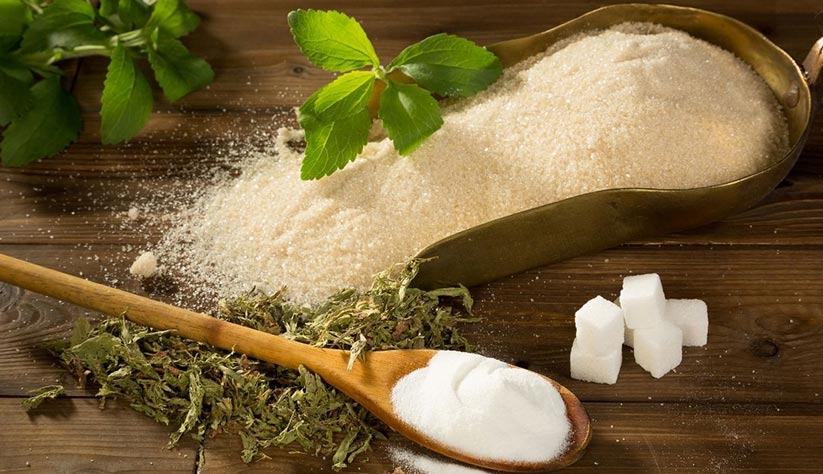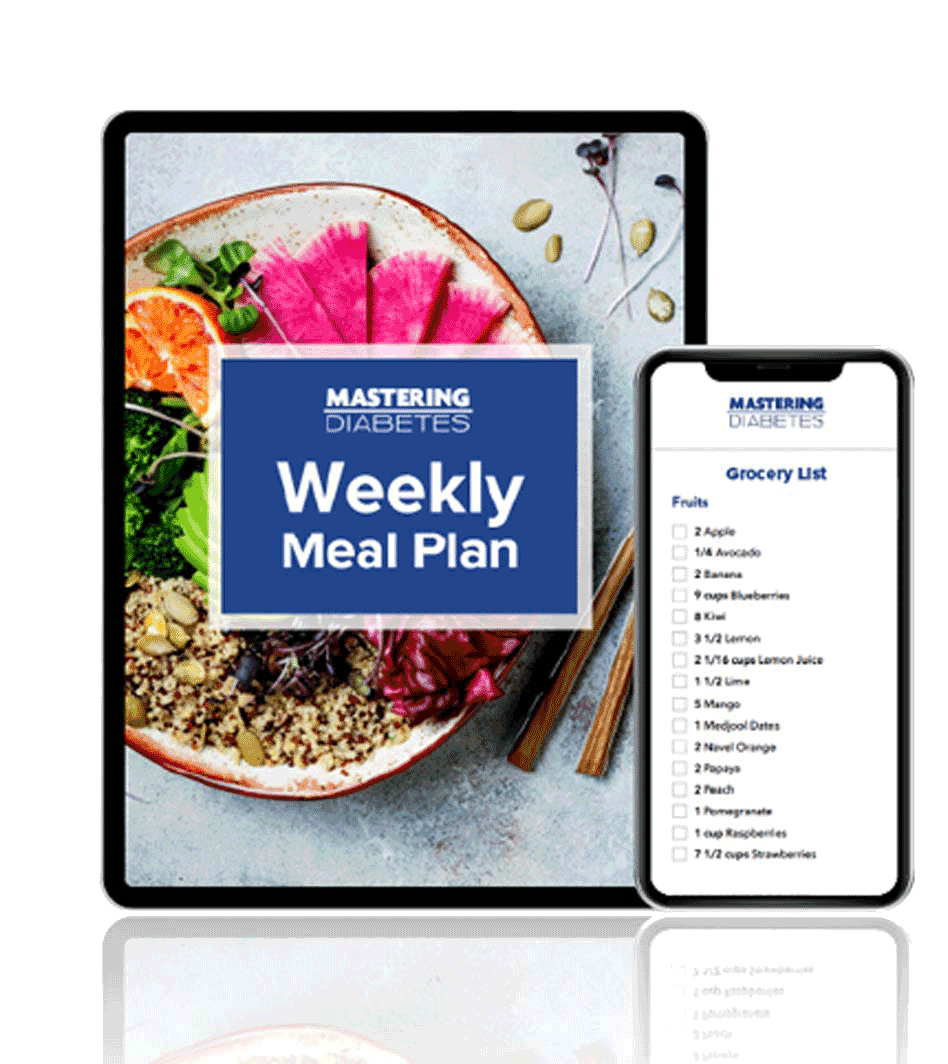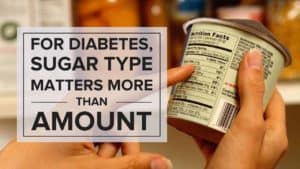
Is Stevia the Best Sweetener for Diabetes?
There’s a lot of misinformation about how to eat when you have diabetes, especially if you’re aiming for weight loss or trying to control your blood glucose (blood sugar levels). This is part of what can make a diabetes diagnosis scary.
Fortunately, the fears that often get repeated about carbohydrates, fruits, natural sugars, and all things with a sweet taste, aren’t entirely accurate.
In this article, we’ll talk about non-nutritive sweeteners like Stevia, which are sugar-free, zero calorie alternatives to fructose, corn syrup, and table sugar that are billed as being much better for people with diabetes.
First, we’ll touch on the types of sugars people with diabetes should avoid, and then discuss how these non-nutritive sweeteners can be a ‘yellow light’ part of your diet (though we don’t recommend making it a staple).
Finally, we’ll discuss the best ways to satisfy your sweet tooth if you’re living with diabetes!
Sugar and Diabetes: Why the Type of Sugar Matters

One of the first major myths about diabetes is that all sugars are bad for you, when in fact this isn’t true.
Refined sugars, added sugars, and artificial sweetening agents are all a form of sugar called simple carbohydrates, which are definitely on our ‘red light’ list of foods to avoid, especially if you’re living with diabetes.
These sugars are directly correlated with higher risk of heart disease and obesity.
Meanwhile, natural sugars like those from fruits and vegetables are on our ‘green light’ list of foods that you can eat ad libitum, or as much as you want.
These foods decrease your risk of all-cause mortality (premature death from any cause), and can actually contribute to reversing insulin resistance and type 2 diabetes.
Most sweeteners, like table sugar and many forms of syrup, are refined sugars, which we definitely recommend avoiding. But what about stevia, and other nonutritive sweeteners?
Stevia and Diabetes: Is Stevia Good for Diabetes?

Stevia (Stevia Rebaudiana) is an herb found in South America and primarily in Brazil, which provides its sweet taste via steviol glycosides, rather than sucrose (which is found in cane sugar and most table sugars).
And in addition to being a zero calorie alternative to artificial sweeteners, there are actually some studied benefits of small amounts of stevia in your diet, thanks to its relatively high antioxidant content and some cardiovascular benefits.
However, despite the approval of some stevia extracts by the Food and Drug Administration (FDA), there are some potential side effects to be aware of.
We’ll go into these potential benefits and side effects below.
Identifying Stevia Products
Stevia sweeteners go by a number of different names and brands, including Truvia, Purevia, Sweet Leaf, and others. However, these sweeteners are all based on extracts from the stevia plant, and have similar benefits and side effects.
Benefits of Stevia for Diabetes
Weight Management
It has been consistently proven that weight loss has benefits for people living with diabetes, as well as on your diabetes risk. And one of the primary advertised benefits of stevia and almost all zero calorie sweeteners is their beneficial effect on your body weight.
It is true that replacing a daily habit of consuming table sugar with coffees, teas, etc. can have a positive effect on your body weight. However, if you’re suffering from obesity or struggling severely with diabetes, there are likely more changes required than just switching sweeteners.
Helps Stabilize Blood Sugar Levels
Where stevia stands apart from many other non nutritive sweeteners is that it actually has some positive effects, rather than simply not having negative effects.
One of these benefits is for blood glucose (blood sugar levels). In multiple studies, small amounts of stevia have shown promise in glycemic health, helping lower blood sugar, without causing hypoglycemia.
Improves Glucose Tolerance
Glucose tolerance is the measure by which individuals are determined to have or not have diabetes, and this is another area where stevia’s mild glucose-processing benefits have an effect.
Stevia has been shown to help your body process glucose, so it makes sense that this would also increase your glucose tolerance, a correlation that has been backed up by the data.
May Lower Blood Pressure
The second of stevia’s potential benefits comes as a blood pressure-lowering agent. Stevia’s benefits here surround stevioside’s promise in promoting better glucose homeostasis (processing of blood glucose), which can have an overall effect on blood pressure.
May Lower Cholesterol
Another area where stevia shows promise is in its ability to help lower ‘bad’ cholesterol and improve good cholesterol.
Especially for individuals with diabetes, introduction of stevia into the diet helped produce a much more favorable lipid profile (measure of cholesterol health). This study was also repeated in individuals without chronic disease, showing stevia’s promise beyond just diabetes.
Can Help Insulin Sensitivity
The final benefits of stevia occur as a result of its proven medicinal effects. Weight loss, better controlled blood glucose, and overall improved health can all help lower your insulin resistance and required insulin levels.
As a result, stevia can have a slightly beneficial effect on your insulin sensitivity.
Risks and Side Effects of Stevia
Some forms of stevia have previously been banned by the FDA, due to the toxicity of some parts of the plant in earlier studies. Since then, the FDA has enforced more stringent regulations on extracts of stevia, so make sure any form you consume is FDA approved.
Though stevia itself, when regulated and consumed in a pure form, tends to have minimal side effects, certain common additives to stevia can have some negative side effects.
For example, sugar alcohols like erythritol, sorbitol, and xylitol, which are often added to stevia, have been known to cause bloating, vomiting, nausea, and indigestion in some cases.
In addition, some of stevia’s documented benefits — lowering blood glucose levels and blood pressure — can be dangerous if you already have hypoglycemia or hypotension.
Other Artificial Sweeteners and Sugar Substitutes for Diabetes

The most comprehensive study to date of stevia and other non-nutritive sweeteners, like saccharin, aspartame, sucralose (ex: Splenda), and acesulfame potassium left researchers with many questions as to the safety and long term risk of these products.
There was little-to-no increase in food intake, cancer risk, risk of diabetes and dental caries, as well as weight gain and obesity, which is good.
But for other side effects like headaches, depression, behavioral and cognitive effects, neurological effects, risk of preterm delivery, cardiovascular effects, or risk of chronic kidney disease, which have been reported to be associated with sweeteners, there was insufficient data.
In summary, while these non-nutritive sweeteners show some potential, and are certainly better than simple carbohydrates like sugar and corn syrup that demonstrably increase your health risk, there is still a great deal of uncertainty as to their long-term safety.
Which Natural Sweetener Is Best for Type 2 Diabetes?

While the research is currently limited on non-nutritive sweeteners as they pertain to long-term risk factors, it’s certainly true that they’re a better option than simple sugars, which the American Diabetes Association classifies as distinct healthcare risks.
Our recommendation around these sweeteners is to take a broad look at your health. As a single change, switching sweeteners likely won’t reverse your risk of diabetes, drastically increase your weight loss, or provide any other major benefits.
But as part of your overall diet and lifestyle change, switching to non-nutritive sweeteners can be a small part of a strategy that can lead to a significantly reduced risk of chronic disease, improved weight, energy, and mood, and even the reversal of type 2 diabetes.
We classify non-nutritive sweeteners as a ‘yellow light’ food, something that’s okay in small quantities, but shouldn’t be a major part of your daily diet.
But that doesn’t mean that you can’t eat healthily and still satisfy that sweet tooth! Our ‘green light’ list of foods and drinks that you can eat ad libitum (as much as you want) is full of fruits, starchy vegetables, and other sweet foods that taste fantastic and improve your health.
You can learn more about our dietary recommendations — including how to eat a fun, flavorful diet while improving your diabetes health — and get expert advice through our blog and coaching program.
Stop Guessing What to Eat
Get Delicious Recipes Sent to Your Inbox Every Week!

Discover the custom-designed Weekly Meal Plan that gives you clarity on what to eat and how to shop to simplify your journey to lower blood sugar, weight loss, and your best A1c




